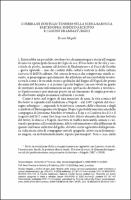Chapter L’ombra di Don Juan Tenorio sulla scena barocca partenopea: indizi d’archivio e canoni drammaturgici
| dc.contributor.author | Megale, Teresa | |
| dc.date.accessioned | 2022-06-01T12:17:38Z | |
| dc.date.available | 2022-06-01T12:17:38Z | |
| dc.date.issued | 2020 | |
| dc.identifier | ONIX_20220601_9788855181501_445 | |
| dc.identifier.issn | 2704-5919 | |
| dc.identifier.uri | https://library.oapen.org/handle/20.500.12657/56262 | |
| dc.description.abstract | This paper highlights archival evidence and dramaturgic mythemes in order to reconsider the historiographical issues related to the XVIIth-century theatrical reception of El burlador de Sevilla y convidado de piedra outside of Spain. Among the crossroads of theatrical practices alive in XVIIth-century Naples, Don Juan underwent a rapid process of assimilation and transformation. The chronology of its Neapolitan debut at the Teatro di San Bartolomeo is re-examined in this paper, while unfolding some new and possible scenarios interweaving history and dramaturgy, the stage and the historical political events of the Kingdom of Naples during the first decades of the XVIIth century. This study examines the Mediterranean basis consolidating the myth of Don Juan – the character with «feet made of wind» (Garboli) – and defining its dramaturgic status all around Europe. | |
| dc.language | Italian | |
| dc.relation.ispartofseries | Studi e saggi | |
| dc.subject.other | El Burlador de Sevilla | |
| dc.subject.other | Naples | |
| dc.subject.other | Teatro di San Bartolomeo | |
| dc.title | Chapter L’ombra di Don Juan Tenorio sulla scena barocca partenopea: indizi d’archivio e canoni drammaturgici | |
| dc.type | chapter | |
| oapen.identifier.doi | 10.36253/978-88-5518-150-1.13 | |
| oapen.relation.isPublishedBy | bf65d21a-78e5-4ba2-983a-dbfa90962870 | |
| oapen.relation.isbn | 9788855181501 | |
| oapen.series.number | 209 | |
| oapen.pages | 14 | |
| oapen.place.publication | Florence |

